[Retracted] The Application of the Depth Model of Precise Matching between People and Posts Based on Ability Perception in Human Resource Management
Abstract
To revitalize talents and give full play to the maximum utility of HR (human resources), it is not enough to accumulate talents alone. HR must be effectively allocated to realize the matching of people and posts. Competency is a personal characteristic of an organization that distinguishes its performance level in a specific job and organizational environment. In order to solve the problem that job seekers’ job-seeking ability is difficult to match the job requirements, this paper combines neural network with traditional HRM (human resource management) algorithm based on ability perception and designs a depth model of accurate matching of people and posts in HR field, which can improve the quality of data training of traditional algorithm. The results show that compared with other algorithms, the F1 value of the proposed algorithm is obviously improved, and the proposed algorithm performs best, with the F1 value of 0.829. In this paper, the method of global network plus local network is used, which can effectively improve the hidden features of data and then improve the matching degree and recommendation accuracy of the algorithm.
1. Introduction
In today’s knowledge age, science and technology represent wealth. The comprehensive quality of human resource management of economists in enterprises and institutions is directly related to the future development of the industry, so it is very important to improve the quality of personnel. In view of the negative impact caused by the fact that some enterprises and institutions do not pay enough attention to the economist, the manager or person in charge of the enterprises and institutions directly takes the role of the economist. Enterprises and institutions must rerecognize the importance of human resource management of economists and change their inherent ideas. Give full play to the main role of the economist’s human resources to make more contributions to enterprises and institutions. This is a responsibility and a high requirement for human resource management of economists. The human resource management of economists should be aware of the competitiveness between enterprises and institutions, actively participate in the planning, and mobilize the enthusiasm of employees while improving their own quality, so as to achieve the goal of common progress between employees and enterprises and institutions. In order to mobilize employees’ work enthusiasm and enhance their sense of competition, the human resource management of economists can give old employees and new employees the opportunity to interact in the form of exchange forums. In addition, the human resource management of economists can also provide training for employees so that they can have a basic understanding of the culture, development strategy, and development status of enterprises and institutions. And further cover workplace etiquette, product knowledge, and other aspects. Promote employees to understand the current situation, advantages, and future planning of the industry more clearly, strengthen their sense of ownership, and encourage them to work harder. Perception model has a wide range of applicability, which is suitable for the HRM (human resource management) process of enterprises of various natures and can help enterprises significantly improve the scientificity and rationality of HRM. The existing job recommendation system can provide accurate, fast, and personalized job recommendation services for job seekers by analyzing their historical search records, mining their job-seeking wishes, needs, and job-seeking tendencies [1, 2]. Through effective personnel-post matching, the quality of enterprise resource management can be comprehensively improved, which plays an important role in enterprise operation and work development. It is also very helpful for enterprises to achieve strategic goals.
In recent years, scholars have tried to apply the cutting-edge technology to the matching of people and posts. In early research abroad, Khan et al. used candidates and professional information to establish two-way recommendation between people and posts and realized the matching between people and posts [3]. Belsito et al. followed the idea of recommendation system and put forward a job recommendation system based on job seekers’ preferences and interests [4]. Reachslin et al. believe that competence is the intrinsic characteristic of an individual, and there is a certain degree of causal relationship between this intrinsic characteristic and related performance in work and situation. The theory of this view of characteristics focuses on the study of people’s competence from the perspective of discovering people’s characteristics [5]. Baimenov et al. think that the company’s operation is made up of orderly work, and different positions have different competency elements for employees, that is, the system theory of person-post matching [6]. Petros et al. pointed out that the matching process of people and posts is a dynamic matching process. The dynamic matching between people and posts is of great significance to help employees obtain career planning and personal development, give full play to their active role, and promote the development of the company [7]. Brueller et al. tried to establish the matching degree model between employees and specific positions by analytic hierarchy process [8]. Liang used AHP (analytic hierarchy process) and fuzzy comprehensive evaluation method to establish a measurement model of the matching degree between people and posts [9]. Mills et al. put forward the dynamic matching model between people and jobs; that is, the matching between people and jobs is a dynamic and active configuration process [10]; Hitka et al. conducted an empirical study on the competency models of top managers in enterprises, and the results showed that the competency models of top managers in the east and the west are similar. This study verified for the first time in China that competency evaluation can more comprehensively distinguish outstanding management cadres from ordinary management cadres [11]. Choi et al. studied various scales of HR (human resources) related to this, and this configuration type of person-post relationship mainly ensures the HR quality of various departments and positions in the enterprise through all links in the HRM process [12].
If we want to study the capability perception model, we need to fully understand not only the characteristics and needs of enterprises but also the development goals, missions, and business development of enterprises. In the process of enterprise development, the matching of people and posts can ensure the smooth implementation of enterprise strategic objectives. In the period of production and operation, the strategic goal is an important guide, and all enterprise activities are carried out around the strategic goal [13, 14]. Excellent employees and ordinary employees will show significant differences in competency. Organizations can use competency indicators as one of the main bases for the recruitment, evaluation, and promotion of employees. Most of the studies have not adopted appropriate and reasonable empirical methods, and almost no one has done the corresponding research on the matching of people and posts after the competency model is built, let alone specific to a certain industry or field, and the research on the matching of people and posts with the competency of HRM employees in enterprises is even blank. In this paper, the ability perception model will be combined to construct the accurate matching model of job and post, and the rich semantic information contained in the long text of job and post features will be fully utilized to realize the accurate matching between job seekers and posts.
2. Research Method
2.1. Analysis of Enterprise Capability Perception Model
To distinguish people, the competency perception model should first classify and match people, positions, and posts. In order to realize the system matching among organizations, posts, and personnel, the effect of only using the general competency model is often not ideal, but we should combine the specific requirements of different organizations and posts to build different post competency models for different posts. At present, there are three main modes of developing competency model: based on the position, based on the overall value and core competence of the organization, and based on the key success factors of the industry. Among them, the post-based competency model is the most common development mode, which has strong applicability and operability, and is easy to be accepted and developed by organizations. Therefore, it has important guidance and practical significance to explore and develop the post competency model for optimizing human resource management. Quality is a necessary condition to produce high performance, and the capability perception model should be able to predict future performance and become a guarantee to support the sustainable development of enterprises in the future [15].
Post management by objectives requires the establishment of post management system, ability evaluation system, performance management evaluation system, and finally a scientific, reasonable, fair, and just HRM system which is competitive in the market and can effectively promote the realization of organizational strategic objectives. It is not difficult to find that employees’ ability and quality influence employees’ work performance, and to a certain extent, their ability and quality determine employees’ work performance, by closely combining their positions and work behaviors.
Social role represents employees’ understanding of social norms, and it is also an important embodiment of employees’ behavior style, such as managers. Self-image is a kind of self-display after employees have a clear understanding of their own abilities and roles, such as self-confidence, which often has a great impact on their performance. This study adopts the method of vectorizing each word after segmentation and then clustering the vectorized words. The results show that this method can effectively distinguish competency from other words so that they can be grouped into one category. The specific implementation process is shown in Figure 1.
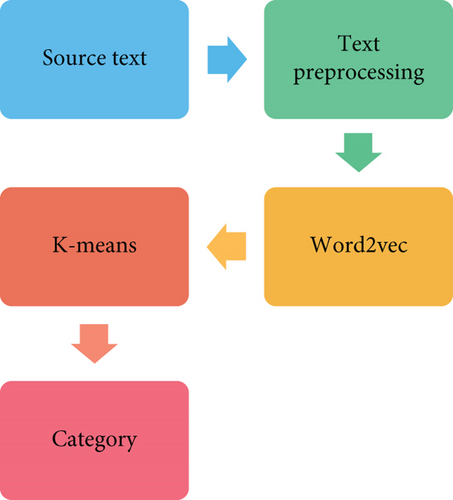
It should be noted that the consistency of the judgment matrix should be checked in layer-by-layer sorting. Generally speaking, the judgment matrix is not required to strictly satisfy this property. This paper studies the difference between judgment consistency matrix and satisfaction consistency matrix. The limitation of determining the acceptance matrix by the consistency index is discussed. In order to improve the consistency of judgment matrix, a new method of correcting matrix by using the average characteristic of judgment is proposed.
The evaluation ability level can adopt the behavior level description method; that is, when the model is built, the behaviors will be laid to different levels according to the difficulty and complexity of behaviors, and when judging, the employees will be anchored to the corresponding ability level according to the difficulty and complexity of behaviors during the evaluation period, and the corresponding ability level scores will be given.
As far as HR quality is concerned, it is necessary to ensure the matching degree of employees’ ability and quality with job requirements and company culture from the beginning of the recruitment process. After employees enter the company, they should strengthen job guidance and training to realize the dynamic matching and management between people and jobs, so as to have a competitive workforce. In the competency model constructed in this study, its hierarchical structure is shown in Figure 2.
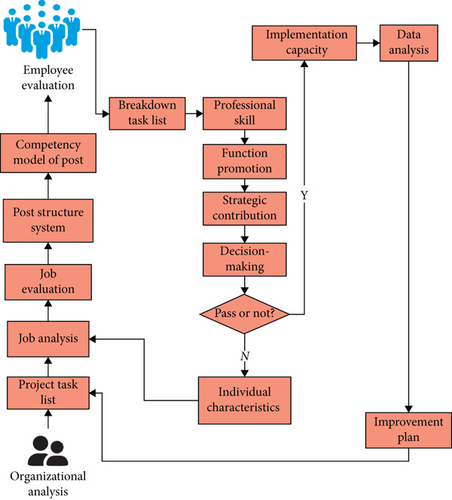
The application of competency perception model can enable enterprises to get rich and useful information, and apply this information to recruitment and evaluation, so as to draw scientific and reliable conclusions. The construction of post competency model provides the basis and standard for people to enter posts and corresponding grades and is an effective way to realize the matching between people and posts [18, 19]. These abilities are difficult to observe and learn. The individual characteristics of factor mainly include a person’s personality, motivation, values, and other characteristics, which are the deepest features and the least easy to be discovered and developed.
2.2. Establishment and Application of Depth Model of Accurate Matching between People and Posts
Person-post matching refers to the corresponding relationship between people and posts. Each incumbent has different abilities, qualities, and individual characteristics, and his or her individual needs and motivations are different. Only when the individual’s needs are matched with the post compensation and organizational vision can the individual be motivated and work harder to achieve greater performance.
Personal abilities and qualities are compatible with job requirements, and personal requirements are matched with the salary level and organizational vision that the job can provide. In this form, the matching between people and posts is at its best. It is the most ideal matching form of “send,” but it is difficult to realize the “send” form. In the process of post selection, if the post holder has work experience related to the post, then the company will save time and cost for the post training of the post holder, and the post holder can adapt to the job quickly.
- (1)
The first step of job matching is to understand job requirements through job analysis, so as to realize job knowledge. For a job, it is to fully collect and observe all kinds of information such as the rights and responsibilities of the job and then analyze the work procedures and summarize the contents and rights and responsibilities
- (2)
Know people: knowing people means judging people’s post competence. Usually, many scientific methods, such as written test, interview, online psychological assessment, and group discussion, are used to identify people
- (3)
Match with people and posts: the fundamental purpose of the whole match is to make people fit for their posts, make the best of their abilities, and finally reap the maximum organizational benefits
At present, there are two main aspects of job matching. The first is the matching between the professional skills of employees and the demands of jobs, and the second is the matching between employees’ work attitude and salary return. Timely training can help enterprises get comprehensive protection, and its training mainly includes four stages: demand analysis, training design, implementation, and result evaluation; enterprises should start to carry out employee training from multiple angles to ensure the perfection of training facilities and the rationality of training funds. In order to achieve the best match between people and posts, it is necessary to carry out post analysis and personnel quality evaluation according to the talent construction plan to recruit and select talents so that the match between people and posts can approach to rationality. When using certain evaluation methods, corresponding evaluation methods should be proposed for each quality element. There may be multiple evaluation methods for a certain quality element, which requires in-depth analysis, comparison, and accurate selection of discarded methods. Do not simplify or complicate the evaluation style. When introducing a new style, it should be verified to determine its applicability. In the contemporary evaluation, test method, oral test method, evaluation center method, and other evaluation methods are commonly used.
At present, most of the competency model and competency model are established by psychological evaluation method, which is inherently scientific, but it will be slightly complicated in the actual operation process of the enterprise, so it will undoubtedly reduce the actual operability of the enterprise and increase the operating cost. The essence of HR scheduling model is to analyze HR data and calculate the matching degree of people and posts. Then, according to the score of matching degree between people and posts, the personnel can be dispatched, which can be abstracted as a recommendation model in essence.
When k = j, indicates that the possessor has the lowest satisfaction with the original position; that is, the position applied for by the job seeker is at least better than the position currently occupied; when k ≠ j, the occupant’s satisfaction with the post is accumulated and obtained through the evaluation satisfaction under each index.
In the process of adjustment, enterprises should combine the specific situation. If there is a problem with employees’ skills, managers should first consider vocational training for employees. If employees’ working ability cannot be improved through training, managers need to consider post adjustment and whether to transfer them to posts with lower requirements.
Group the data to get a more comprehensive understanding of the characteristics of the HR model. At the same time, the data is saved in the data warehouse, which can support the subsequent data model training. The depth model of accurate matching between people and posts combined with ability perception is shown in Figure 3.
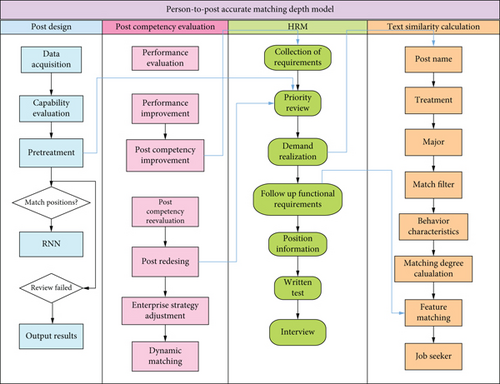
In the text similarity calculation layer, the attribute values with long text in the matching features of people and posts are vectorized by using Word2vec method, and then, the matching degree of corresponding features is evaluated by calculating the cosine distance between corresponding features. Embedding each word into the vector model, more strictly speaking, generates a vector space with a large number of text so that each word can find the corresponding vector, and the similarity between words can be calculated. Then, the data is abstracted, preprocessed, encoded by an encoder, and stored in a data warehouse. If the new evaluation results show that people and posts are matched, then the adjustment scheme can be determined; if not, the adjustment will be made according to the third step again until people and posts are matched to achieve dynamic balance.
3. Result Analysis
This paper extracts and analyzes the research resumes through network big data. According to the fields in the obtained resume data and combined with the opinions of relevant experts, different variables such as working hours, enterprise scale, rank, highest degree, school grade with the highest degree, HRM major, student cadre experience, internship experience, and award-winning experience are extracted from the resume data and processed in a structured way.
Taking the average of the total scores of three experts as dependent variables and eight variables extracted from resumes as independent variables, multiple regression analysis was carried out to explore the factors in resumes that have significant influence on competency, and they were used as input variables of competency prediction model. The results are shown in Figure 4.
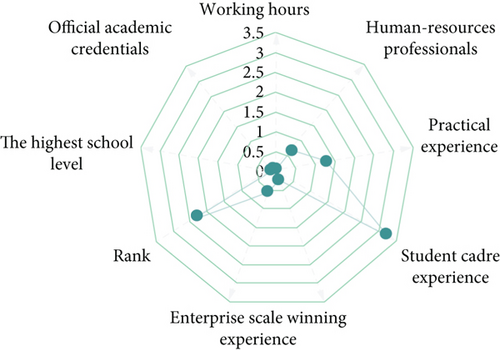
We can see that whether or not there is internship experience has a significant impact on competency at the level of 1%, and its coefficient is 1.32. Compared with those who have no internship experience, those who have relevant experience have a higher level of competence. This further proves the importance of practice for HRM work. High-level schools have certain advantages in terms of faculty, curriculum, and the combination of theory and practice. Students will get more resources and have more practical opportunities during their education, which will have a positive impact on their competence.
Combine the development strategy of the enterprise, fully consider the requirements of the enterprise in HRM posts, and design, adjust, and improve the current HRM posts. For job seekers, if they are matched to poor positions, there will be a big psychological gap, and then, they will lose interest and enthusiasm for work. As for the position, if you match a poor job seeker, it violates the idea of recruiting excellent talents, which is obviously unacceptable to the enterprise. All job seekers form a matching pair with the position that prevents it, and all matching pairs form a matching scheme. Job seekers who are not blocked by jobs and jobs that are not blocked by jobs are not matched.
Performance management can not only significantly improve employees’ work enthusiasm and efficiency but also play an important role in promoting the smooth development of departmental work. Although HR planning includes three aspects, their common foundation is based on the establishment and analysis of the post ability perception model, so it can provide scientific, reasonable, and effective information for the HRM work of enterprises, help enterprises achieve accurate HR planning, and ensure the full use of HR.
The relative importance weights of many indicators in each level to the related indicators in the previous level have been obtained, and the total ranking is made from top to bottom. The results are shown in Figure 5.
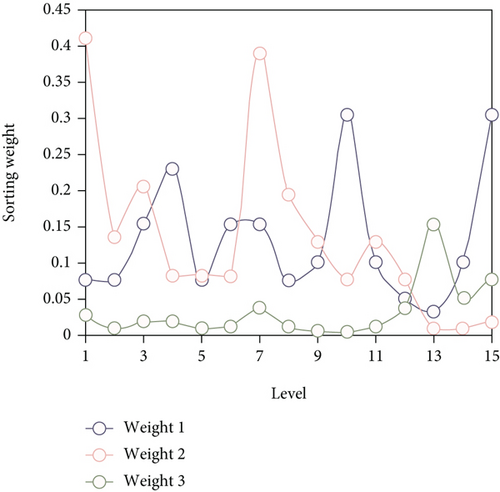
According to the calculation results, it can be seen that the strategic management and change management have relatively high weights, while HRM functional management and enterprise support management have relatively low weights in the latitude of enterprise HR supervisor competency evaluation. In addition to the necessary requirements for posts, enterprises also have an in-depth understanding of employees’ mental health. With the all-round development of economy, the competition among enterprises also increases invisibly, which also intensifies employees’ psychological pressure. Every employee has his own advantages and disadvantages, so managers need to put forward corresponding suggestions according to the actual situation of employees when they carry out HRM.
An enterprise’s recruitment method based on capability perception model is an innovation based on the traditional recruitment method to meet the requirements of the development of the times. Conduct situational interviews and behavioral event interviews during the interview process. Add the weight of competency score to the comprehensive recruitment score, as shown in Figure 6.
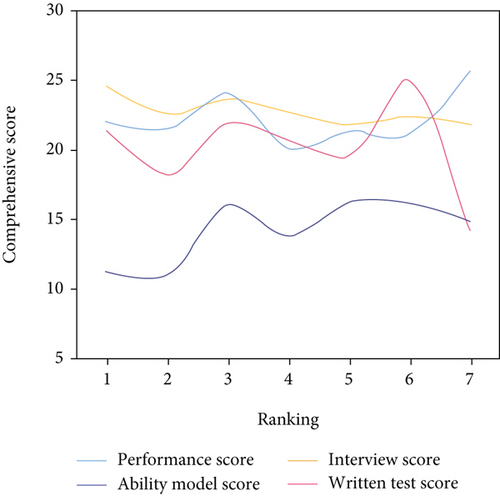
Comprehensive practice shows that interviewers can evaluate the implicit characteristics of candidates more by means of scenario simulation and case analysis, so as to judge the matching degree of candidates and then make the decision on whether to hire or not according to the post ability perception model. Improve motivation, attitude, and behavior, so as to be better qualified for the current job or new job, and then, promote the improvement of organizational efficiency and the realization of organizational strategy and promote personal career development.
The most critical method of training demand analysis based on the competency perception model is to compare the difference between the employee’s actual competency and the target post competency. The person position matching in the enterprise’s human resource management is to select the appropriate personnel and match the determined positions. The person who is engaged in this position needs to have the ability to complete the job responsibilities well. These indicators should be measurable, observable, and instructive and have a key impact on the personal performance of employees and the success of the enterprise. At the same time, it is necessary to adjust various problems in the combination process to ensure the realization of the post objectives. Only by getting the correct post gap information can the training demand be accurately analyzed. The training content corresponds to each competency item, which constitutes the corresponding relationship between training content and competency item. Then classify it, and determine the training content and training methods according to it so that training courses can be developed in a targeted manner, and the main contents of training courses formulation can be guaranteed, including training course name, category, training method, training hours, training objectives, training contents, and assessment methods.
In this paper, the data classify and sort out the HR data of enterprises, and the data includes three types: personnel information, personnel evaluation matrix value, and personnel ability matrix value. Then, the feasibility of the proposed algorithm is compared. The proposed algorithm, Ref. [14] method, and Ref. [16] method are used for model training and experimental analysis. The evaluation indexes are accuracy, recall, and F1 value. The experimental results are shown in Table 1.
It can be seen that compared with the other two algorithms, the F1 value of the proposed algorithm is obviously improved, and the proposed algorithm performs best, with the F1 value of 0.829. In this paper, the method of global network plus local network is used, which can effectively improve the hidden features of data, then improve the training quality of data, and improve the matching degree and recommendation accuracy of the algorithm.
Person-post matching in HRM of an enterprise is to choose the right person to match the determined position and, at the same time, take corresponding measures to combine the two together. At the same time, it is necessary to adjust all kinds of problems in the process of combination, so as to ensure the realization of the post goal.
The core of job matching is that the matching between people and jobs can reach the most reasonable state, that is, people can play the most effective role in jobs, and jobs can also give people the greatest satisfaction, so as to obtain the best performance. The post competency model can help employees to further clarify their quality development goals, so as to carry out career development planning more effectively, point out the development path for employees, and promote employees to improve their sense of responsibility for their own career and organizational development.
4. Conclusion
Job matching is a relatively complicated process. To achieve this, it is necessary for enterprises to optimize the distribution of jobs in combination with their own development in order to improve the job matching degree. In this paper, the depth model of accurate matching between people and posts based on ability perception is put forward, which takes into account the needs of job seekers and posts in reality, as well as the characteristics of occupiers in matching. By using genetic algorithm to solve the multiobjective optimization model, the best matching scheme under different requirements can be obtained. Compared with the other two algorithms, the F1 value of the proposed algorithm is obviously improved, and the proposed algorithm performs best. It shows that this model can effectively imitate the behavior of experts and make competency evaluation based on resumes, thus realizing the automatic operation of matching ability and position in resume screening, effectively improving the efficiency, and providing a reference for enterprises to accurately position high-quality talents. However, the study still has some limitations. The model also needs to consider the different needs of job seekers and positions in the real world and needs to be expanded and supplemented in future research.
Conflicts of Interest
The author declares that there are no known competing financial interests or personal relationships that could have appeared to influence the work reported in this paper.
Open Research
Data Availability
The data used to support the findings of this study are available from the corresponding author upon request.




